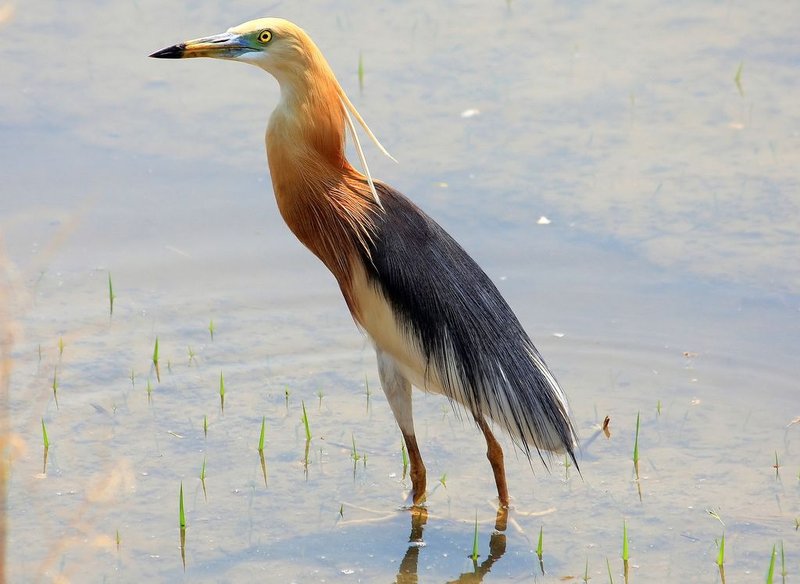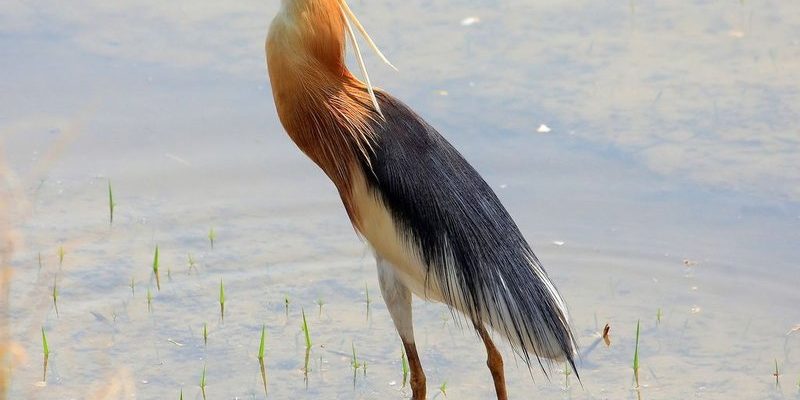
The Javan Pond Heron is a fascinating bird that graces the wetlands of Southeast Asia, particularly in Indonesia. Imagine a creature that looks like it’s dressed in a natural tuxedo, with its striking plumage shimmering in the sunlight as if it were ready for a royal banquet. These graceful herons are not just lovely to look at; they play an essential role in their environment and offer insights into the delicate balance of ecosystems. So, let’s dive deeper into the captivating world of the Javan Pond Heron.
Besides their beauty, these herons are renowned for their adaptability. They thrive in various habitats, from shallow ponds and rice fields to marshy areas. It’s almost like they have a natural flair for finding the best spots to hunt and snatch up their next meal. If you’re curious about where they come from, their behaviors, and how to identify them, you’re in the right place. We’ll unpack all things Javan Pond Heron in this article.
Habitat
The Javan Pond Heron typically chooses to inhabit areas that are rich in water sources, such as marshes, ponds, and rice paddies. Think of these locations as a buffet for the herons, filled with delicious treats like fish, insects, and crustaceans. The lush vegetation surrounding these bodies of water provides them with shelter and a perfect vantage point for hunting.
They prefer shallow waters where they can easily wade and search for food. In fact, you might spot them standing motionless, waiting patiently for the right moment to strike. The shallow depths also make it easier for them to blend into their surroundings, as they often rely on their camouflage to avoid potential predators. Their ability to adapt to both natural and human-altered environments is one reason they thrive in Southeast Asia.
Physical Characteristics
The Javan Pond Heron is not just any heron; it’s a beautiful spectacle of nature. Adult birds are slender, with long necks and legs, making them perfectly designed for their watery habitat. Their plumage is primarily a soft white, but it can transition to shades of rusty brown and cream, especially during the breeding season. This color change acts as a signal for potential mates. Imagine a fashionable bird choosing its outfit based on the occasion!
One of their defining features is their strong, straight bill, which they use to catch prey effectively. Adults usually reach a height of about 60 to 75 cm and have a wingspan of around 100 cm when their wings are fully spread. These birds are graceful in flight, gliding effortlessly with their long wings extended. If you ever have the chance to watch them soar, you might find it a mesmerizing sight—a true dance of elegance.
| Attribute | Description |
|---|---|
| Size | About 60 to 75 cm in height |
| Wingspan | Approximately 100 cm |
| Coloration | Primarily white, with rusty brown and cream during breeding |
| Diet | Fish, insects, and crustaceans |
| Habitat | Wetlands, marshes, and rice fields |
| Lifespan | About 10 years in the wild |
Behavior
When it comes to behavior, the Javan Pond Heron is quite the character. They are known for their unique hunting style, which often involves stealth and patience. Picture this: a heron standing still for what seems like an eternity, waiting for the perfect moment to dart in and catch its prey. This method, combined with their excellent eyesight, allows them to spot movement in the water, making them highly effective hunters.
You might also notice that they are social birds, often seen foraging in small groups. These gatherings can lead to interesting interactions, as they communicate with each other through a variety of calls and body language. When they feel threatened, they may engage in a behavior called “fleeing,” where they quickly take off in flight to escape danger. Their quick reflexes are vital for survival in the wild.
Breeding and Nesting
Breeding season for the Javan Pond Heron is a captivating time. During this period, males display their vibrant plumage to attract females, showcasing their most glamorous look like they are on a fashion runway. After courting, pairs will work together to build nests in the dense vegetation near water sources. These nests are typically made from twigs, reeds, and other aquatic plants, creating a cozy haven for their eggs.
Once the female lays her eggs, both parents take turns incubating them, usually for about 3 weeks. After hatching, the chicks are born covered in downy feathers and are surprisingly mobile. They quickly learn to forage for food, which is primarily provided by their parents in the early stages. Watching the caring interactions between the parents and their young can be truly heartwarming.
Conservation Status
As beautiful as the Javan Pond Heron is, it faces threats that put its survival at risk. Habitat destruction due to agricultural expansion and urban development poses a significant challenge. Wetlands are drained to make way for buildings or fields, cutting into the heron’s living space. Pollution in these environments can also affect the food sources that these birds depend on.
Conservation efforts are crucial to ensuring the future of the Javan Pond Heron. Programs focused on habitat preservation aim to protect the delicate ecosystems that support these herons. By raising awareness and promoting sustainable practices, we can contribute to the well-being of this elegant bird and its home. It’s a collaborative effort, and every little action counts.
Where to See Javan Pond Herons
If you’re interested in spotting a Javan Pond Heron, Southeast Asia is the place to be. Popular spots include wetlands in Indonesia, particularly Java, where these herons thrive in abundant water sources. Visiting during the breeding season might give you the chance to see these birds in their most vibrant attire, showcasing their stunning appearance.
Birdwatching tours and local guides can enhance your experience, providing valuable insights into the behavior and nesting habits of these herons. It’s an opportunity to connect with nature and appreciate the beauty of wildlife in its natural habitat. Grab your binoculars and a field guide, and get ready for an adventure!
FAQ
What is the diet of the Javan Pond Heron?
The Javan Pond Heron primarily feeds on fish, insects, and crustaceans found in shallow waters. They are skilled hunters, using their sharp eyesight and stealth to catch prey. Their diet can vary depending on the availability of food sources in their habitat. During the breeding season, they tend to forage more actively to provide for their chicks.
How does the Javan Pond Heron adapt to changes in its environment?
These herons are quite adaptable and can thrive in both natural and human-modified environments. They can adjust their hunting methods and food preferences based on the available resources. For instance, in agricultural areas, they may rely more on insects and small fish found in rice fields. This adaptability is key to their survival in a changing world.
Are Javan Pond Herons social birds?
Yes, Javan Pond Herons are social creatures and often forage in small groups. This social behavior allows them to communicate and potentially increase their chances of hunting success. They engage in various calls and display behaviors to interact with one another, creating a dynamic and lively scene in their habitats.
What are the main threats to the Javan Pond Heron?
The primary threats to the Javan Pond Heron include habitat destruction due to agricultural development and urbanization. Pollution of water sources can also impact their food supply. Conservation efforts focused on protecting wetlands and promoting sustainable practices are essential to ensure their survival.
How long do Javan Pond Herons live?
In the wild, Javan Pond Herons typically have a lifespan of about 10 years. However, this can vary based on environmental conditions and threats. Those who manage to avoid predators and locate sufficient food sources are more likely to live longer, healthy lives.
Can I observe Javan Pond Herons in other regions besides Java?
While they are primarily found in Java, Javan Pond Herons can also inhabit other areas in Southeast Asia. They are often seen in wetlands, marshes, and rice paddies throughout Indonesia and neighboring countries, such as Malaysia. Birdwatchers can explore various regions to increase their chances of spotting these elegant birds.
How does breeding season affect the appearance of Javan Pond Herons?
During the breeding season, male Javan Pond Herons exhibit more vibrant plumage, transitioning to shades of rusty brown and cream. This change in appearance serves as a visual cue to attract potential mates. The dazzling display adds a layer of competition among males as they seek to impress females with their beauty.
Why are wetlands important for the survival of Javan Pond Herons?
Wetlands provide crucial habitats for many species, including the Javan Pond Heron. These ecosystems support a rich variety of food sources, such as fish and insects, essential for their diet. Wetlands also offer protection and nesting areas, making them vital for the heron’s breeding success and overall survival.
What role do Javan Pond Herons play in their ecosystem?
Javan Pond Herons contribute to the balance of their ecosystems by controlling the population of fish and insects. As predators, they help maintain healthy food webs and prevent overpopulation of certain species. Their presence indicates a healthy wetland environment, making them valuable indicators of ecological health.
How can individuals help conserve Javan Pond Herons?
To help conserve Javan Pond Herons, individuals can support local conservation initiatives focused on protecting wetlands and their habitats. Simple actions, like reducing pollution and promoting sustainable farming practices, can make a difference. Educating others about the importance of these birds and their environments also raises awareness and fosters community efforts.

